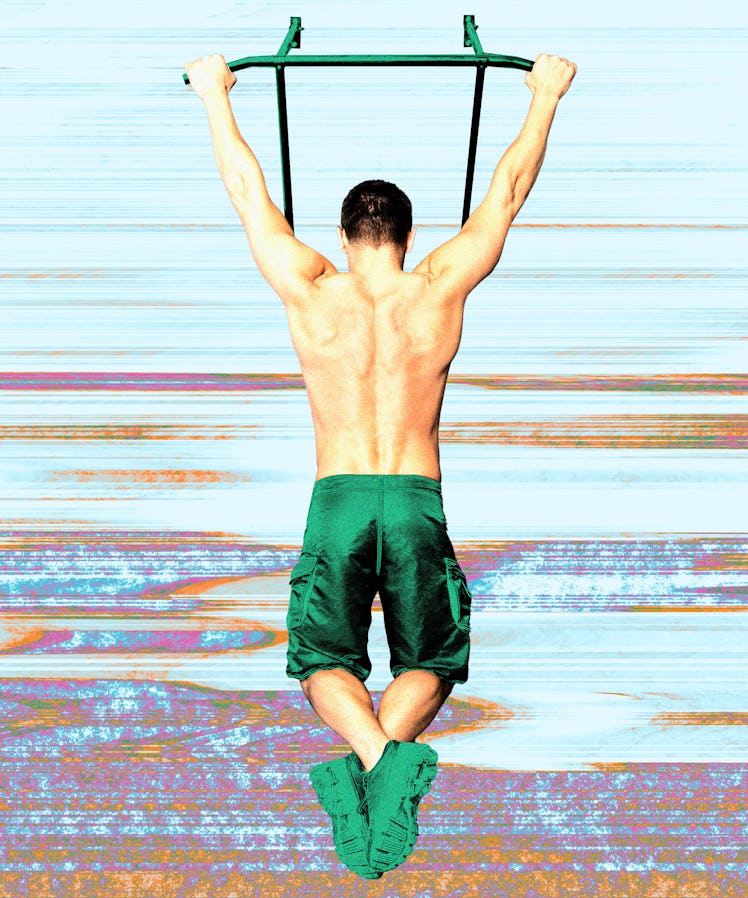The Dead Hang TikTok Fitness Trend Will Make Your Back Feel Amazing
This fundamental exercise not only improves shoulders and grip strength but also decompresses your aching back.

Forget fancy footwork and synchronized dances, open up the TikTok app right about now and you’re likely to see fitness influencers doing a lowly, common dead hang. A dead hang — as the name implies — is basically hanging from a bar and, well, that’s it. If you were to ask a fitness expert about this trend, however, you’d find that TikTokers are onto something.
“The recent dead hang trend on TikTok shines a new light on a classic and fundamental movement,” says personal trainer Daniel Richter, CEO of StrengthLog. “Fitness enthusiasts share videos of themselves doing the dead hang exercise while listing the benefits and the often satisfying feelings in the back, shoulders, and arms.”
Matt Scarfo, a personal trainer for Lift Vault, notes that these TikTok videos are especially popular with fit creators that can hang for a few minutes at a time. “They show the creator hanging from behind, and then their spine decompressing as a result of the hang.”
So how do you do a dead hang? It’s fairly straightforward. “Dead hangs are a grip and shoulder strength exercise that involves hanging from a pull-up bar,” says Scarfo, noting that you should keep your shoulders and back loose as you hang. “Don’t try to hunch your shoulder to bring stability to your body, as these dead hangs help you build grip and can help decompress your back.” To get those dead hang benefits, you need to let everything but your hands go loose.
If you don’t have access to a pull-up bar, you can hang from anything that can hold your weight, whether that be gymnastic rings or a tree branch, Richter says. “Hang still with straight arms, with your palms facing away from you. Use your thumbs to grip around the bar if you can,” he says. “Try to relax and sink deep into the hanging position by letting your arms extend, and your shoulders naturally move closer to your ears.” This is called a passive hang and is the most popular variant of the exercise. “You can also do an active hang, where you activate your shoulders and pull your scapulae down,” he says.
Dead Hang Benefits
Dead hanging gives a much-needed break from our hunched-over-computer lives. “The dead hang exercise offers a type of movement that we very rarely do in today's modern society, but for which our biology is still very well suited,” says Richter. “For people who mostly spend their time sitting, hunched forward, and with their arms hanging by their sides, the dead hang provides much-needed variation and exercise for our backs, shoulders, arms, and grip.”
Our shoulders in particular can lose mobility and strength when we sit in front of our computers all day, and the dead hang exercise effectively and gently helps reverse this. “Many people have limited shoulder mobility, especially when your arms are overhead,” Scarfo adds. “Dead hangs stretch these shoulder muscles and joints so that you can restore that mobility.”
Dead hangs work another aspect of fitness you’re probably missing: grip strength. “Hand and forearm strength is often hard to build, so dead hangs help you build that by forcing you to support your body weight on your grip alone,” says Scarfo.
Decompression is a big win from doing dead hangs, too, and the major one touted on TikTok. “The weight of your body pulls your spine straight, which can help you decompress your spine, hips, and upper back,” says Scarfo.
We spend a lot of time with our spine compressed. When we sit, stand, or walk around, our spine is compressed by gravity, Richter says. “By hanging, your back relaxes, and your spine can decompress, which reduces pressure on the intervertebral discs,” he says. “This might help the discs regain their form and elasticity, while simultaneously letting nutrient-rich fluids flow back in, which can make your back feel better and reduce back pain.”
Alleviating that spinal disk compression is key. “Decompressing your back helps relieve compression of the disks, which can pinch nerves and cause pain for many folks. By relieving that pressure, you’ll feel more mobility between the vertebrae and improve posture,” says Scarfo. In this way, dead hanging has many of the same benefits as inversion tables.
Richter recommends starting your dead hangs gradually, for example, by doing three to four sets of dead hangs for 30 to 60 seconds each, spread throughout the day. You can gradually build on this until you hold each hang for a few minutes, if you’d like.
“You can also vary your hanging: Hang with your palms away from you or facing you,” says Richter. If you’re up for a real challenge, you can hang from one arm at a time.
Scarfo stresses that you shouldn’t be discouraged if you can’t hold a dead hang for very long to start. “It’s challenging to build the grip strength needed to hold your body for 20 or 30 seconds,” he says. You can start working on your grip strength by doing things like holding groceries while walking through the door, or holding weightlifting plates for extended periods.
“Even a short dead hang can give you the benefits of spinal decompression, so work at getting longer, and reap the benefits slowly,” Scarfo says.
This article was originally published on